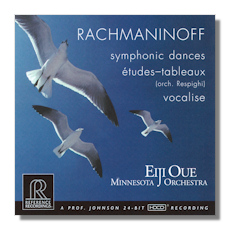I am sure that I am not alone here in that during the 1970s (and I guess for the 60s for those of you who grew up then), I unknowingly did not look after my hearing. As a youngster, I was charged with mowing the family lawn - all 1400 square metres of it - each and every weekend over summer and perhaps every other weekend in Spring and Autumn. That is two hours of an engine going full throttle less than two metres from my ears. Back in the mid 70s, there was simply no awareness of the dangers of noise exposure. I don't even think you could go anywhere to buy ear protection. No one ever wore it even if you could get it. And certainly no one ever warned me of the dangers - parents, doctor, school - no one. And I remember that after mowing the lawn, I couldn't hear properly for well into the same afternoon - it wasn't till late afternoon that my hearing felt "right" again.
And this went on for year after year until suddenly one day someone woke up to the dangers, it became "public health" knowledge and - at least the smart ones which now included me - kitted up with hearing protection. Whilst I also studied and listened to recorded music, it was never ever remotely loud enough to actually cause a threshold shift in my hearing (which is actually the correct term though I never knew that in the 70s). It was only ever when using power tools such as the lawn mower. Recorded music was actually a "quiet" hobby believe it or not.
In much later life I had a hearing test and given the damage I'd unknowingly done cutting the grass decades before, I was surprised to see the losses had been thankfully relatively minor (about 5 dB in the left ear and 10dB in the right at the "noise notch" frequencies). It could have been far worse and I was told that pretty much everyone has damage to some extent. Suffice to say that ever since I had that hearing test a decade ago, I've been extra careful, though nothing is ever going to undo the damage I caused myself - probably along with millions of other young people of that era and earlier ones.
There has only ever been one instance in my entire life where listening to actual music itself caused a threshold shift. And that was at a live concert in Sydney of a Shostakovich Symphony. I decided there and then that this was my last ever live concert - at least for the foreseeable future - and I cancelled my yearly subscription after that. I felt that having to wear musician's ear plugs at a live classical concert was half-defeating the purpose of being there in the first place. It was there and then that I became serious once again about great sound reproduction in my home, even though it had been an on and off hobby of mine since the age of around 8.
So what does the state of my hearing have to do with dynamic range in music? It is simply that in order for the softest bits to be heard with absolute clarity, the loudest bits can and do reach uncomfortable levels. In fact, I've measured some very good domestic audio systems with high dynamic range classical material and if you go by the notion that 30 dBA is about as soft as you are prepared to go in order to hear, say, a solo part in an orchestral work, then you are pushing past 110 dBA when everyone is going flat out. This is not only uncomfortable listening. It is also dangerous - literally. These levels are common in an actual concert hall but clarity at such extremes is much more difficult to achieve with a domestic audio system in a domestic setting as most of us would know.
With all that said then, I have always struggled with the immense dynamic range inherent in classical music. So far as recorded classical music is concerned, the dynamic range is as much about the actual work and composer as it is the orchestra, conductor, hall and recording techniques used. I suspect that some labels such as EMI and DGG used subtle compression to tame dynamic range routinely, though not in such a way that you are overtly aware of it. EMI, for example, had some wonderful audio recording consoles with some killer limiter and compression modules onboard - more about that later. And for the most part, when listening to DG recordings from the late 50s to early 70s, I am never overwhelmed by the dynamic range because the softest parts are clear and simply significantly louder than they are on other labels such as Decca (where I believe signal processing was absolutely taboo). I think RCA did a far bit of gain riding on their mixers even in the Living Stereo days - there is just no way I hear what I am hearing on those recordings unless there were additional spot mikes that were pushed in and out as needed.
Anyway, up until last week this had been a problem I had begrudgingly lived with. My only "solution" was to either listen to our national Classical FM station (which obviously needs to use compression), or limit my listening sessions to only a couple of one-hour sessions per week. With popular music, it simply isn't a problem at all. With such a small dynamic range it is very easy for me to find a low volume level that is satisfying - even at a level measuring about 56 dBA, that is more than enough for popular music so far as I am concerned. But with classical, it has just been a losing battle.
Here is graph below to show what I am talking about. This is a wave form representation of a Reference Recordings vinyl LP (Rachmaninoff Symphonic Dances - RM1504) I bought a couple of years ago. Look at the peaks versus the softest bits - it's nuts. And this is the half-speed mastered vinyl pressed at Quality Record Pressings - as good as it is, the soft bits "include" all the analogue noise - turntable rumble, vinyl surface noise, etc!!:
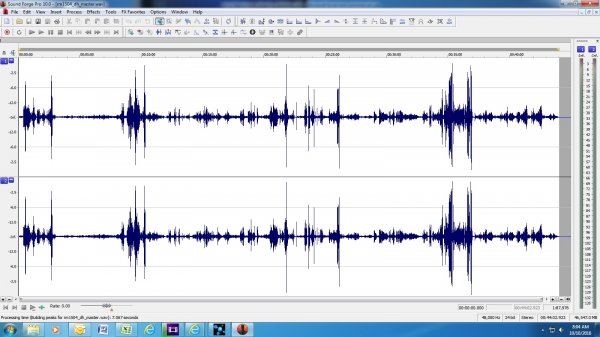
And here is a far older recording. Ravel's Bolero - an early 1960s Decca reissue by Speakers Corner - Ansermet with the Swiss Romande:
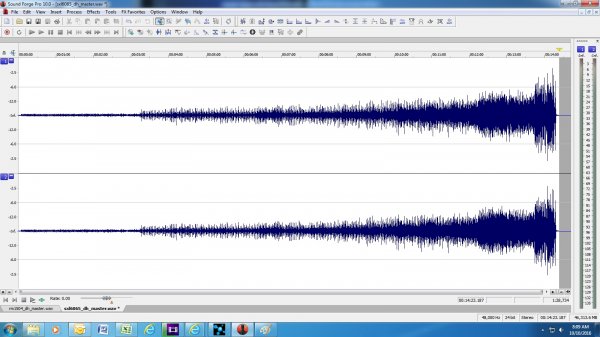
So why have I now "solved" this problem? Well, remember earlier in this post I mentioned the compressor / limiter modules used by EMI? Two years ago, a company called Waves collaborated with Abbey Road to release a plug-in emulation of the famous EMI TG12345 channel strip. Plug-ins are software that can be used on a digital audio workstation and they are able to replicate - within technological constraints of course - the workings of the original piece of actual hardware. Typically the original piece of analogue hardware is exhaustively put through all of it's paces and the results painstakingly measured. This particular TG12345 strip was used in the recording chain for the Beatles and (if I recall correctly) Pink Floyd amongst other famous artists. I am not sure if it was used with classical but since many classical recordings were made at Abbey Road right when this console was in use, I think it may well have been.
I decided last week to download the demo version of it (7 day limit) and started to experiment. Bearing in mind that the vast majority of users are processing popular music, it did take me quite some time to find the best setting for classical. But once I found it, what can I say other than I am hugely impressed. I have mucked with plug-ins of various sorts for years now and for the most part they are very underwhelming. Most of them - in doing what they are designed for - sling proverbial mud all over the pristine audio being processed. Inother words, the colourations are so great, they simply cannot be considered of any use to a purist.
But this Abbey Road TG12345 plug-in is a completely different ball game. Think of the very best (but subtle) compression that the best classical music FM stations might have used back in the old days where sound quality really mattered above everything else (I am thinking here of ABC FM in Australia back in the late 1970s to early 80s) - but then up the ante again a couple of notches in terms of sheer audio performance and transparency. The bottom line is that I have found a way to process my music in such a way that dynamics are no longer excessive and yet the essential quality of the music is unaffected.
Below is the aforementioned Reference Recordings graph after applying the best compression setting I could come up with - bearing in mind that I wanted the effect to never actually draw attention to itself and that the whole point is to be able to reduce the volume control setting. With this new file, I can turn the volume down by about 7 dB versus the original. That is a huge improvement:
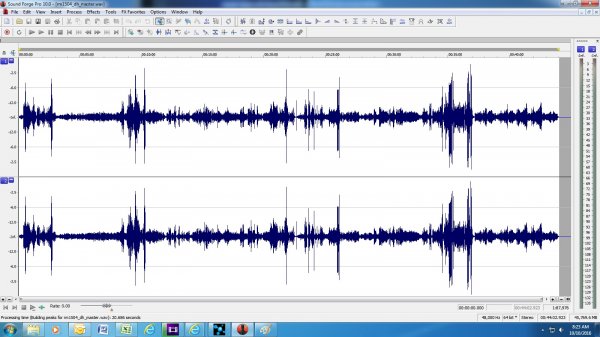
Same with the Bolero. Again, a "saving" of around 7 dB on the volume control yet you'd only be aware of the compression if you directly compared it to the original:
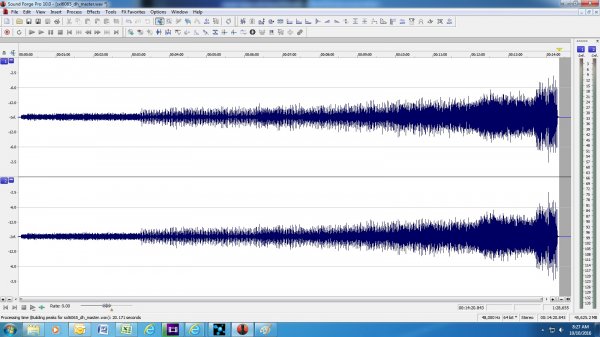
Of course, it is quite possible to add a limiter / compressor to the actual audio system itself but then you run into practical issues that high resolution software processing avoids. Apart from that, you would have to spend huge amounts of money to employ a limiter of the same calibre.
Anyway, if nothing more, I hope this post will give people cause to consider how dynamic range in music and the associated volume control setting needed to accommodate it can be rather unfriendly to our ears. As I say, this is not really a problem with popular music but it is a very big one with classical music. And the "better" the recording, usually the bigger the "problem" is.
And this went on for year after year until suddenly one day someone woke up to the dangers, it became "public health" knowledge and - at least the smart ones which now included me - kitted up with hearing protection. Whilst I also studied and listened to recorded music, it was never ever remotely loud enough to actually cause a threshold shift in my hearing (which is actually the correct term though I never knew that in the 70s). It was only ever when using power tools such as the lawn mower. Recorded music was actually a "quiet" hobby believe it or not.
In much later life I had a hearing test and given the damage I'd unknowingly done cutting the grass decades before, I was surprised to see the losses had been thankfully relatively minor (about 5 dB in the left ear and 10dB in the right at the "noise notch" frequencies). It could have been far worse and I was told that pretty much everyone has damage to some extent. Suffice to say that ever since I had that hearing test a decade ago, I've been extra careful, though nothing is ever going to undo the damage I caused myself - probably along with millions of other young people of that era and earlier ones.
There has only ever been one instance in my entire life where listening to actual music itself caused a threshold shift. And that was at a live concert in Sydney of a Shostakovich Symphony. I decided there and then that this was my last ever live concert - at least for the foreseeable future - and I cancelled my yearly subscription after that. I felt that having to wear musician's ear plugs at a live classical concert was half-defeating the purpose of being there in the first place. It was there and then that I became serious once again about great sound reproduction in my home, even though it had been an on and off hobby of mine since the age of around 8.
So what does the state of my hearing have to do with dynamic range in music? It is simply that in order for the softest bits to be heard with absolute clarity, the loudest bits can and do reach uncomfortable levels. In fact, I've measured some very good domestic audio systems with high dynamic range classical material and if you go by the notion that 30 dBA is about as soft as you are prepared to go in order to hear, say, a solo part in an orchestral work, then you are pushing past 110 dBA when everyone is going flat out. This is not only uncomfortable listening. It is also dangerous - literally. These levels are common in an actual concert hall but clarity at such extremes is much more difficult to achieve with a domestic audio system in a domestic setting as most of us would know.
With all that said then, I have always struggled with the immense dynamic range inherent in classical music. So far as recorded classical music is concerned, the dynamic range is as much about the actual work and composer as it is the orchestra, conductor, hall and recording techniques used. I suspect that some labels such as EMI and DGG used subtle compression to tame dynamic range routinely, though not in such a way that you are overtly aware of it. EMI, for example, had some wonderful audio recording consoles with some killer limiter and compression modules onboard - more about that later. And for the most part, when listening to DG recordings from the late 50s to early 70s, I am never overwhelmed by the dynamic range because the softest parts are clear and simply significantly louder than they are on other labels such as Decca (where I believe signal processing was absolutely taboo). I think RCA did a far bit of gain riding on their mixers even in the Living Stereo days - there is just no way I hear what I am hearing on those recordings unless there were additional spot mikes that were pushed in and out as needed.
Anyway, up until last week this had been a problem I had begrudgingly lived with. My only "solution" was to either listen to our national Classical FM station (which obviously needs to use compression), or limit my listening sessions to only a couple of one-hour sessions per week. With popular music, it simply isn't a problem at all. With such a small dynamic range it is very easy for me to find a low volume level that is satisfying - even at a level measuring about 56 dBA, that is more than enough for popular music so far as I am concerned. But with classical, it has just been a losing battle.
Here is graph below to show what I am talking about. This is a wave form representation of a Reference Recordings vinyl LP (Rachmaninoff Symphonic Dances - RM1504) I bought a couple of years ago. Look at the peaks versus the softest bits - it's nuts. And this is the half-speed mastered vinyl pressed at Quality Record Pressings - as good as it is, the soft bits "include" all the analogue noise - turntable rumble, vinyl surface noise, etc!!:

And here is a far older recording. Ravel's Bolero - an early 1960s Decca reissue by Speakers Corner - Ansermet with the Swiss Romande:

So why have I now "solved" this problem? Well, remember earlier in this post I mentioned the compressor / limiter modules used by EMI? Two years ago, a company called Waves collaborated with Abbey Road to release a plug-in emulation of the famous EMI TG12345 channel strip. Plug-ins are software that can be used on a digital audio workstation and they are able to replicate - within technological constraints of course - the workings of the original piece of actual hardware. Typically the original piece of analogue hardware is exhaustively put through all of it's paces and the results painstakingly measured. This particular TG12345 strip was used in the recording chain for the Beatles and (if I recall correctly) Pink Floyd amongst other famous artists. I am not sure if it was used with classical but since many classical recordings were made at Abbey Road right when this console was in use, I think it may well have been.
I decided last week to download the demo version of it (7 day limit) and started to experiment. Bearing in mind that the vast majority of users are processing popular music, it did take me quite some time to find the best setting for classical. But once I found it, what can I say other than I am hugely impressed. I have mucked with plug-ins of various sorts for years now and for the most part they are very underwhelming. Most of them - in doing what they are designed for - sling proverbial mud all over the pristine audio being processed. Inother words, the colourations are so great, they simply cannot be considered of any use to a purist.
But this Abbey Road TG12345 plug-in is a completely different ball game. Think of the very best (but subtle) compression that the best classical music FM stations might have used back in the old days where sound quality really mattered above everything else (I am thinking here of ABC FM in Australia back in the late 1970s to early 80s) - but then up the ante again a couple of notches in terms of sheer audio performance and transparency. The bottom line is that I have found a way to process my music in such a way that dynamics are no longer excessive and yet the essential quality of the music is unaffected.
Below is the aforementioned Reference Recordings graph after applying the best compression setting I could come up with - bearing in mind that I wanted the effect to never actually draw attention to itself and that the whole point is to be able to reduce the volume control setting. With this new file, I can turn the volume down by about 7 dB versus the original. That is a huge improvement:

Same with the Bolero. Again, a "saving" of around 7 dB on the volume control yet you'd only be aware of the compression if you directly compared it to the original:

Of course, it is quite possible to add a limiter / compressor to the actual audio system itself but then you run into practical issues that high resolution software processing avoids. Apart from that, you would have to spend huge amounts of money to employ a limiter of the same calibre.
Anyway, if nothing more, I hope this post will give people cause to consider how dynamic range in music and the associated volume control setting needed to accommodate it can be rather unfriendly to our ears. As I say, this is not really a problem with popular music but it is a very big one with classical music. And the "better" the recording, usually the bigger the "problem" is.







